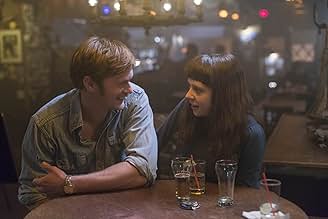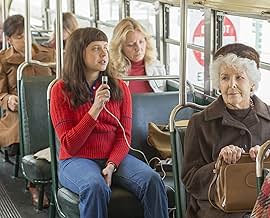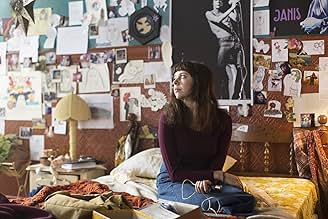Une adolescente à San Francisco dans les années 1970 a une liaison avec le petit ami de sa mère.Une adolescente à San Francisco dans les années 1970 a une liaison avec le petit ami de sa mère.Une adolescente à San Francisco dans les années 1970 a une liaison avec le petit ami de sa mère.
- Réalisation
- Scénario
- Casting principal
- Récompenses
- 16 victoires et 37 nominations au total
Susannah Rogers
- Voice of Aline Kominsky
- (voix)
- (as Susannah Schulman)
Avis à la une
An honest, unfiltered & nonjudgmental coming of age drama about a young woman's sexual endeavours, The Diary of a Teenage Girl is a nicely crafted, sensibly narrated & wonderfully performed cinema that's highly bohemian in nature, emanates a psychedelic vibe from start to finish & is further uplifted by its well-put together cast.
Based on the graphic novel of the same name, the story of The Diary of a Teenager is set in San Francisco during the 1970s and concerns Minnie, a 15-year old aspiring cartoonist who in the wake of her sexuality begins a relationship with her mother's boyfriend. However, her longing for love & acceptance soon sets her on a path to much bolder adventures.
Written & directed by Marielle Heller in what is her filmmaking debut, The Diary of a Teenage Girl is oddly stylish, surreal & provocative in depicting the sexual & artistic awakening of its protagonist and captures the highs & lows of adolescent life with utmost sincerity. Heller's direction is as good as her screenplay, and it's refreshing to see the story being told from a girl's perspective.
Production design team does a good job in replicating the 1970s setting, Cinematography makes splendid use of its camera & bright colour tones to further enhance its images, and Editing is finely carried out while the music fits its scene. Coming to the performances, Bel Powley delivers a terrific performance and is brilliantly supported by Alexander Skarsgård, Kristen Wiig & others.
On an overall scale, The Diary of a Teenage Girl is a bold example of its genre that attempts to capture the turmoil of teenage years without sugarcoating any of it, is capable of leaving a few viewers squirming on their seats with its explicit nature, and thanks to its playful tone & sensible handling of its characters, is a welcome entry in the coming-of-age filmmaking landscape. Definitely worth a shot.
Based on the graphic novel of the same name, the story of The Diary of a Teenager is set in San Francisco during the 1970s and concerns Minnie, a 15-year old aspiring cartoonist who in the wake of her sexuality begins a relationship with her mother's boyfriend. However, her longing for love & acceptance soon sets her on a path to much bolder adventures.
Written & directed by Marielle Heller in what is her filmmaking debut, The Diary of a Teenage Girl is oddly stylish, surreal & provocative in depicting the sexual & artistic awakening of its protagonist and captures the highs & lows of adolescent life with utmost sincerity. Heller's direction is as good as her screenplay, and it's refreshing to see the story being told from a girl's perspective.
Production design team does a good job in replicating the 1970s setting, Cinematography makes splendid use of its camera & bright colour tones to further enhance its images, and Editing is finely carried out while the music fits its scene. Coming to the performances, Bel Powley delivers a terrific performance and is brilliantly supported by Alexander Skarsgård, Kristen Wiig & others.
On an overall scale, The Diary of a Teenage Girl is a bold example of its genre that attempts to capture the turmoil of teenage years without sugarcoating any of it, is capable of leaving a few viewers squirming on their seats with its explicit nature, and thanks to its playful tone & sensible handling of its characters, is a welcome entry in the coming-of-age filmmaking landscape. Definitely worth a shot.
In many ways a period piece, this indie film captures a very special time period in San Francisco, a time when counterculture flourished and withered, people experimented and abused all kinds of substances, and teen artist Minnie experiences a lot of firsts, in the eternal search for acceptance, love, and a sense of purpose.
In spite of a brave, earnest, and raw performance by a deliberately exposed Bel Powley, very believable as a teenager in the aforementioned period, and of a subtle, nuanced and understatedly magnetic one by the great Alexander Skarsgård, this movie falls short because its characters are sadly just a bit too immature, selfish, and unlikable.
While that sounds very much like the typical description of the stereotypical youth, it remains nonetheless a major fault in the script how unsympathetic Minnie is throughout, with no real point of self-reflection or regrets over some of her actions, refusing to deal with the consequences of even her more heinous ones.
Surrounded by egotistical, likewise emotionally stunted, at times manipulative adults, it may be no wonder that the main character is unable to learn or grow much, but the level of navel-gazing is still a bit too grating, with the protagonist of this clearly autobiographical story experiencing life events without any sort of moral compass whatsoever.
The film drags towards the end, perhaps because of the fragmented, increasingly hazy way the story is told as the movie progresses, but also because by then we care very little about the fate of the different characters. Though this intimate film does hit some high notes in terms of mood, acting, and cinematography, the end result is unsatisfying.
(+) The reconstruction of 70's San Francisco is very well done. Some of the scenes really hit the point. Mood and color palette also well done.
(-) Unsympathetic characters, starting with the amoral, self- centered protagonist, doom the movie.
In spite of a brave, earnest, and raw performance by a deliberately exposed Bel Powley, very believable as a teenager in the aforementioned period, and of a subtle, nuanced and understatedly magnetic one by the great Alexander Skarsgård, this movie falls short because its characters are sadly just a bit too immature, selfish, and unlikable.
While that sounds very much like the typical description of the stereotypical youth, it remains nonetheless a major fault in the script how unsympathetic Minnie is throughout, with no real point of self-reflection or regrets over some of her actions, refusing to deal with the consequences of even her more heinous ones.
Surrounded by egotistical, likewise emotionally stunted, at times manipulative adults, it may be no wonder that the main character is unable to learn or grow much, but the level of navel-gazing is still a bit too grating, with the protagonist of this clearly autobiographical story experiencing life events without any sort of moral compass whatsoever.
The film drags towards the end, perhaps because of the fragmented, increasingly hazy way the story is told as the movie progresses, but also because by then we care very little about the fate of the different characters. Though this intimate film does hit some high notes in terms of mood, acting, and cinematography, the end result is unsatisfying.
(+) The reconstruction of 70's San Francisco is very well done. Some of the scenes really hit the point. Mood and color palette also well done.
(-) Unsympathetic characters, starting with the amoral, self- centered protagonist, doom the movie.
Been hopelessly hooked, for the past several days now, to the captivating selection of 1970s pop that forms the music soundtrack of The Diary of a Teenage Girl.
The film itself, about a teenage girl discovering and embracing sex amidst the Bohemian surroundings of 1970s San Francisco, impressed me for its rare honesty, its vibrancy, and the wonderful music soundtrack that accompanies the film's moods. Phoebe Gloeckner's searing and much acclaimed 2002 graphic novel comes to screen with a careful selection of eclectic tracks from the 1960s-70s that make the film soar at times. The film is not for the prudish and easily shocked though. And that includes the nannies at the Academy who have completely shut out this indie from this years Oscar nominations!
The film itself, about a teenage girl discovering and embracing sex amidst the Bohemian surroundings of 1970s San Francisco, impressed me for its rare honesty, its vibrancy, and the wonderful music soundtrack that accompanies the film's moods. Phoebe Gloeckner's searing and much acclaimed 2002 graphic novel comes to screen with a careful selection of eclectic tracks from the 1960s-70s that make the film soar at times. The film is not for the prudish and easily shocked though. And that includes the nannies at the Academy who have completely shut out this indie from this years Oscar nominations!
San Francisco, 1976: Minnie (Bel Powley) is a 15-year old who initiates a sexual affair with the boyfriend (Alexander Skarsgard) of her mother (Kristen Wiig).
"Diary" has much in common with "Fish Tank", a 2009 British film in which Michael Fassbender played the role of the boyfriend. But "Diary" can't be accused of copying the other film as it is based on the biographical graphic novel by Phoebe Gloeckner. Each film has its own strength and uniqueness.
There is much discomfort in the early sex scenes for obvious reasons. At least, Powley was an adult when the film was being made. But while the film clearly goes into taboo territory, it does so in a way that surprisingly comes off as moving rather than cheap and exploitative.
The story is told through Minnie's (Gloeckner's) perspective so, as it turned out, there seem to be no belief in victims or predators. While there are consequences for the very unconventional liaison, there is no sense of melodramatic punishment that would be expected in other current stories.
Director Marielle Heller does a great job in recreating the carefree attitude of San Francisco in the 1970s as she does in getting fine work from Powley and Skarsgard. The constant partying and indulgences in sex, booze, and drugs was simply the way of life back then and the lightness in attitude comes through in a way that is almost nostalgic. This attitude would crash later after the onset of AIDS, the Reagan years, and real estate speculation (the single-parent family lived in a big apartment in downtown San Francisco on a librarian's salary - something that couldn't happen today). There is also the enjoyable bonus of animated images that accompany Minnie's thoughts and reflections.
This movie succeeds in taking a controversial subject and expressing it convincingly with heart. - dbamateurcritic
"Diary" has much in common with "Fish Tank", a 2009 British film in which Michael Fassbender played the role of the boyfriend. But "Diary" can't be accused of copying the other film as it is based on the biographical graphic novel by Phoebe Gloeckner. Each film has its own strength and uniqueness.
There is much discomfort in the early sex scenes for obvious reasons. At least, Powley was an adult when the film was being made. But while the film clearly goes into taboo territory, it does so in a way that surprisingly comes off as moving rather than cheap and exploitative.
The story is told through Minnie's (Gloeckner's) perspective so, as it turned out, there seem to be no belief in victims or predators. While there are consequences for the very unconventional liaison, there is no sense of melodramatic punishment that would be expected in other current stories.
Director Marielle Heller does a great job in recreating the carefree attitude of San Francisco in the 1970s as she does in getting fine work from Powley and Skarsgard. The constant partying and indulgences in sex, booze, and drugs was simply the way of life back then and the lightness in attitude comes through in a way that is almost nostalgic. This attitude would crash later after the onset of AIDS, the Reagan years, and real estate speculation (the single-parent family lived in a big apartment in downtown San Francisco on a librarian's salary - something that couldn't happen today). There is also the enjoyable bonus of animated images that accompany Minnie's thoughts and reflections.
This movie succeeds in taking a controversial subject and expressing it convincingly with heart. - dbamateurcritic
"The Diary of a Teenage Girl" is a film that shouldn't be as uncommon as it is for American cinema. It's a seriously contemplative and revealing drama about a young woman lost and confused about her sexual identity upon committing one of society's most serious taboos and realizing that she liked it and might want to try it again. And again. And enough times to keep an audio diary of her thoughts and experiences about said act.
I'll catch you up; set in 1970's San Francisco, Minnie (Bel Powley), a fifteen-year-old girl and aspiring cartoonist, experiences her sexual awakening after losing her virginity to her mother's sorta-boyfriend Monroe (Alexander Skarsgård). Minnie considers herself overweight and undesirable in every sense, and is largely neglected by her Bohemian mother Charlotte (Kristen Wiig), who is usually too busy smoking weed or doing drugs with strangers to even notice her daughter, so this awakening comes as an immense shock to Minnie and her person.
Minnie begins to crave more sex and attention from Monroe, going as far as to make intimate sex with him a regular thing, in addition to craving sex from strangers and other boys her age, all under her mother's nose. This sex drive, however, is deeper than horniness, but a cry by Minnie for companionship, desire, and, most of all, love. Minnie wants to be the apple of someone's eye, so much so that when she leaves, the person feels like they'll die without her company and security.
I've long had the same hunger Minnie has had, though I've been fortunate, as a male, to see roughly two or three coming of age films that accurately reflect my emotions, my desires, and my sexual awakening. Young girls and stories of their sexual awakening have been cruelly shortchanged in American film and "The Diary of a Teenage Girl" takes note of that just by existing. Consider scenes when Monroe and Minnie have sex, makeout with one another, or Minnie describes past sexual advances to her best friend. If these scenes made you at all uncomfortable, uneasy, or awkward (like they did me), then writer and directress Marielle Heller has effectively proved that fact without even saying it. Now switch the genders of the two main characters, think about the situation over again, and see if you feel that same level of discomfort.
Heller unapologetically details Minnie's desires in a way that, while revealing, is whimsical, thanks to the presence of Minnie's drawings springing to life before her eyes. However, this occasional distraction is offset by Heller's honest depiction of Minnie and, most importantly, the rawer scenes of the film, like when we see Minnie stand naked before a mirror as she examines her body and voices her desire to be loved and cherished. It's something I'm sure most young girls have done at least a few times in their life; standing before a mirror entirely exposed and hoping someone will love you for all of you rather than just parts of you. It's the basic level of human feeling, and Minnie has discovered it and craves it much quicker than any of her friends have.
Bel Powley is a force on-screen here, positioning herself not as a fabled caricature but an empowering everygirl that transcends beyond the confines of a typical teenage girl into somebody many can relate to. It also helps that Powley, herself, is such a great screen presence, confident even when her character is insecure, and encapsulated in a bubble that teeters between innocence and the loss of innocence.
"The Diary of a Teenage Girl" could easily be paired with "Turn Me On, Goddammit!," a Norwegian coming of age drama about a girl relatively the same age as Minnie, who becomes entranced with masturbation and sexual pleasure so much so that it takes over her life. Truly impacting and significant coming of age stories for young girls are depressingly few and far between and here is a film that boldly asserts itself by silently calling audiences out on its double standards for young women, focusing on a relatable protagonist throughout the film, giving us artful direction and attractive aesthetics not as a means to sugarcoat but to humanize, and concluding the picture with an ending that, while unfortunately fairly radical for American cinema, hits as hard as some of the best endings of films this year.
I'll catch you up; set in 1970's San Francisco, Minnie (Bel Powley), a fifteen-year-old girl and aspiring cartoonist, experiences her sexual awakening after losing her virginity to her mother's sorta-boyfriend Monroe (Alexander Skarsgård). Minnie considers herself overweight and undesirable in every sense, and is largely neglected by her Bohemian mother Charlotte (Kristen Wiig), who is usually too busy smoking weed or doing drugs with strangers to even notice her daughter, so this awakening comes as an immense shock to Minnie and her person.
Minnie begins to crave more sex and attention from Monroe, going as far as to make intimate sex with him a regular thing, in addition to craving sex from strangers and other boys her age, all under her mother's nose. This sex drive, however, is deeper than horniness, but a cry by Minnie for companionship, desire, and, most of all, love. Minnie wants to be the apple of someone's eye, so much so that when she leaves, the person feels like they'll die without her company and security.
I've long had the same hunger Minnie has had, though I've been fortunate, as a male, to see roughly two or three coming of age films that accurately reflect my emotions, my desires, and my sexual awakening. Young girls and stories of their sexual awakening have been cruelly shortchanged in American film and "The Diary of a Teenage Girl" takes note of that just by existing. Consider scenes when Monroe and Minnie have sex, makeout with one another, or Minnie describes past sexual advances to her best friend. If these scenes made you at all uncomfortable, uneasy, or awkward (like they did me), then writer and directress Marielle Heller has effectively proved that fact without even saying it. Now switch the genders of the two main characters, think about the situation over again, and see if you feel that same level of discomfort.
Heller unapologetically details Minnie's desires in a way that, while revealing, is whimsical, thanks to the presence of Minnie's drawings springing to life before her eyes. However, this occasional distraction is offset by Heller's honest depiction of Minnie and, most importantly, the rawer scenes of the film, like when we see Minnie stand naked before a mirror as she examines her body and voices her desire to be loved and cherished. It's something I'm sure most young girls have done at least a few times in their life; standing before a mirror entirely exposed and hoping someone will love you for all of you rather than just parts of you. It's the basic level of human feeling, and Minnie has discovered it and craves it much quicker than any of her friends have.
Bel Powley is a force on-screen here, positioning herself not as a fabled caricature but an empowering everygirl that transcends beyond the confines of a typical teenage girl into somebody many can relate to. It also helps that Powley, herself, is such a great screen presence, confident even when her character is insecure, and encapsulated in a bubble that teeters between innocence and the loss of innocence.
"The Diary of a Teenage Girl" could easily be paired with "Turn Me On, Goddammit!," a Norwegian coming of age drama about a girl relatively the same age as Minnie, who becomes entranced with masturbation and sexual pleasure so much so that it takes over her life. Truly impacting and significant coming of age stories for young girls are depressingly few and far between and here is a film that boldly asserts itself by silently calling audiences out on its double standards for young women, focusing on a relatable protagonist throughout the film, giving us artful direction and attractive aesthetics not as a means to sugarcoat but to humanize, and concluding the picture with an ending that, while unfortunately fairly radical for American cinema, hits as hard as some of the best endings of films this year.
Le saviez-vous
- AnecdotesThe classroom scenes were shot at Lincoln Middle School in Alameda, CA. Although the film crew was given permission to shoot in the school, the school staff objected to the content of the script and insisted no filming be done at any time when students could possibly be on campus. As such, the classroom scenes were shot on a single night, with lights outside the windows to give the appearance of daytime.
- Crédits fousJoint Roller Lindsay Hannon
- ConnexionsFeatured in The Tonight Show Starring Jimmy Fallon: Chris Meloni/Luke Bryan (2015)
- Bandes originalesLooking for the Magic
Written by Dwight Twilley
Performed by Dwight Twilley Band
Courtesy of Capitol Records under license from Universal Music Enterprises
Meilleurs choix
Connectez-vous pour évaluer et suivre la liste de favoris afin de recevoir des recommandations personnalisées
Everything New on Hulu in August
Everything New on Hulu in August
There's a whole lot to love about Hulu's streaming offerings this month — get excited for brand-new series premieres and film favorites to watch at home.
Détails
- Date de sortie
- Pays d’origine
- Site officiel
- Langue
- Aussi connu sous le nom de
- Diario de una chica adolescente
- Lieux de tournage
- Sociétés de production
- Voir plus de crédits d'entreprise sur IMDbPro
Box-office
- Budget
- 2 000 000 $US (estimé)
- Montant brut aux États-Unis et au Canada
- 1 477 002 $US
- Week-end de sortie aux États-Unis et au Canada
- 52 334 $US
- 9 août 2015
- Montant brut mondial
- 1 775 133 $US
- Durée
- 1h 42min(102 min)
- Couleur
- Mixage
- Rapport de forme
- 2.35 : 1
Contribuer à cette page
Suggérer une modification ou ajouter du contenu manquant







































